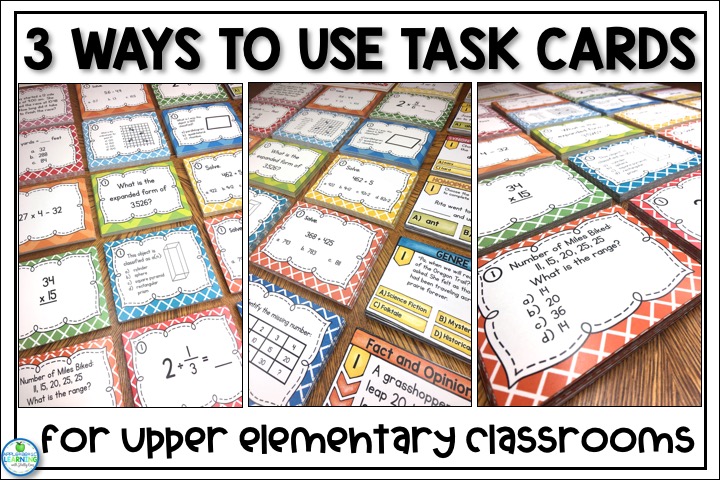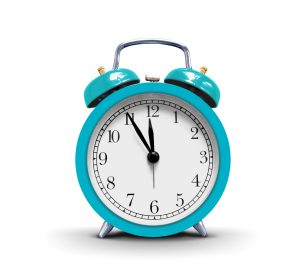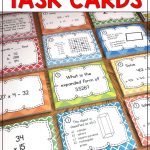

Task cards are a wonderful resource to use in the classroom. They are most commonly used as independent learning centers, but there is so much more you can do with task cards. Here’s 3 new ways to use task cards in your upper elementary classroom to engage your students in learning.
Playing games in the classroom is one of the best ways to engage your students. There’s something that happens when you say “Let’s play a game” that instantly gets your students excited and involved. After all, who doesn’t love a good game.
Unless you purchase a pre-made learning game, it can be difficult to put a game together on your own. The hardest part of creating your own learning game is coming up with enough questions to give your students the necessary practice for a skill. Task cards to the rescue! Now you use task cards for any skill and instantly have the questions you need for a quality learning activity.
Choose the game that you want to play. You can use a store bought board game, play a classroom version of a sport, or create your own jeopardy style game.
To play a whole class game based on a popular sport, simply project an image of the field or court onto your white board or smart board.
Then create or find something you can use to represent the teams or players. This could be as simple or complicated as you want. A super easy way for baseball is to give each student a sticky note and have them write their name on it. The sticky notes can easily be moved around the bases as hits are scored. For a team game like football you only need one marker per team.
Last, decide on the rules and share them with the class. Try to make the rules resemble the actual game and be something that works for your class. Keep it simple! For baseball, each correct answer could count as a hit allowing the team member to move forward one base. An incorrect answer could count as one out. The first team will continue batting (answering questions) until they have 3 outs. Then the next team gets a turn to bat.
You could also make it a little more challenging by dividing up the questions into different stacks by difficulty. The easiest stacks would be a single (allowing the player to move one base), the questions that are slightly harder could be a double (allowing the player to move two bases), the next level of difficulty could be for a triple (allowing the player to move ahead 3 bases) and the most difficult questions could be for home runs (allowing the player to move all the way around the bases and score).
You create the rules to fit the needs of your classroom and the time you have available. When you are ready to play, simply divide your class into two teams, grab your task cards and have fun!
You can also create a reusable jeopardy board that can be used again and again. By using library pocket holders or envelopes glued onto a poster board you will be ready to play jeopardy at any time. Simply slide the task cards into the slots and get playing. Here’s one I found on Pinterest that was created by Stephanie Finley.
Using task cards to play games is a FANTASTIC way to review for end of the year standardized testing. In the last few days before the test, students (and teachers) need a little break from the test prep. This doesn’t mean you have to stop reviewing, but just change it up a little. By grabbing multiple sets of task cards, you can cover multiple skills in one review game.
Using task cards for small group instruction or intervention is a wonderful way to differentiate for the needs of your students. Task cards are designed to work on one skill or concept at a time. Therefore, it becomes very easy to reteach or provide guided practice on a specific skill using task cards.
During your small group or intervention time, grab a set of task cards that focuses on the specific skill you will be teaching. Instead of using paper and pencil, make this a special and fun activity and pull out dry erase boards and dry erase markers. There’s something about just changing up the writing method that makes it feel less like work. If you don’t have a set of dry erase boards, students can write directly on the desk or tabletop with the dry erase marker. It should wipe clean, but if there is anything remaining just grab a Magic Eraser sponge.
Here’s a few different ways you can use task cards in a small group setting.
One way to engage the students more is to allow them to choose the task card that the group will complete. By placing the task cards out, face up, students can see each question and choose the one they want to work on. It’s no surprise that they will often choose the cards that they think are easy and that they can answer correctly. No worries! There is power in feeling successful and once your students correctly complete a couple task cards on their own you will see their confidence building.
Allowing students to “be the teacher” is also a great way to help them master a skill or concept. Let the students take turns explaining how they completed a task card. Students will often explain things in a little different way than teachers do and this might be just what another student needs to have that A-ha light bulb moment. Since you are working with the small group you are still present to correct any misinformation or guide the student teaching experience.
One final way to use task cards during small group instruction is to play “Correct the Teacher.” As you model solving problems or work on guided practice as a group, make a mistake on purpose. Let the group know from the beginning that you will be making mistakes and that it is their job to correct you. The nice part about this game is that you can intentionally make mistakes in the areas that you know the students are struggling with.
If you’ve been in the classroom for any amount of time you know that no matter how well you plan, there always seems to be these little pockets of time in the day that need to be filled. Task cards are a great way to fill those small time gaps. You can control the amount of time by deciding how many task cards to do. Here are some common time gaps in the day where task cards are very helpful.

Arrival time often includes a lot of “dead time” because students come in at different times. There are also lots of administrative things that you need to do at the beginning of the day (attendance, lunch choices, etc). Finally, students need to unpack and get ready for the day. None of these are activities that can be perfectly coordinated with time. So why not use task cards as Morning Work to help fill this time and get students working on a task.
A Bell Ringer or Morning Work activity is one that students complete when they arrive. You set the procedure for what arrival time looks like in your classroom. Quite often it goes something like this: arrive at the classroom and unpack your backpack, put your personal belongings in your locker or assigned space, mark your lunch choice on the board, then go to your seat and get started with your morning work. There’s no right or wrong way to have students arrive. Just set up the procedure that helps you accomplish all those administrative things you need to have done first thing when class starts.
Project a couple of task cards on the front board or copy them on paper so students will be able to work on them when they arrive. Skills that have already been taught are the best so that students can work independently, leaving you able to finalize attendance or other duties.
The end of a class period or lesson often holds a few extra minutes. Use a task card that relates to the lesson or skill that was just completed. Have students complete the task card on a sticky note or scrap piece of paper with their name on it. As they leave class they will hand you their answers. Known as exit slips, they contain some valuable information for the teacher.
By reviewing the exit slips, you get a very good understanding of where your students are after the lesson. You can quickly tell who has a good understanding of the concept and who might need reteaching.
Sometimes, those time gaps just happen in the middle of the day at the most random times. By keeping a stack of task cards near the front of the room you can grab them at any time. As you teach new skills and concepts, add to this stack so that there is always a review of skills just ready and waiting. Then when those time gaps occur you are prepared and can quickly fill them.
Another time gap happens when some students finish an assignment quickly. There is a balancing act that happens as you give the rest of the class enough time to complete the assignment while still keeping the early finishers busy so they don’t become a distraction.
Use task cards to set up an Early Finisher space in your classroom. This could be a bulletin board or a book shelf, a notebook or a file folder. Whatever space or area you have available will work. Then fill this area with task cards that students can complete independently. Just make sure to have all the supplies they might need so that you are free to continue working with the other students in class.
For example, you might include some writing task cards that would require paper. Maybe you have some spelling list task cards that require markers or play dough, or reading task cards that need some paper or a book. Whatever it might be, just make sure your students know how to find the task card and any supplies.
As students complete an assignment they know they can go to this area for their next task.
Task cards are one of the most versatile resources you will find for your classroom. If you are looking for more ideas on using and organizing task cards check out these blog posts.
You can find task cards for many different skills and concepts. These math task cards will have you covered for the entire school year. With 22 sets of math task cards included, you will have all your skills and concepts covered!
Save these task card ideas for later use by pinning this to your favorite Pinterest board. Then you will easily be able to get back here to find what you are looking for.

Hi, I’m Shelly! Thank you for being here. I love helping third, fourth, and fifth grade teachers with fun and engaging activities that require no to little prep! Let me help you by taking some of the stress and work off your plate.

©2022 Shelly Rees. All Rights Reserved.
